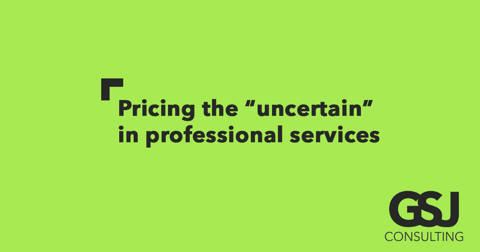Professional services firms: pricing the uncertain

Pricing work that lacks clear deliverables, predictable timelines, measurable outcomes or a defined scope of services is one of the biggest challenges professional services firms face today. On the one hand, clients want cost certainty and expect you, as the professional, to have a better grasp of the likely costs than they do. On the other hand, 100% of the pricing risk rests with you.
But, whether you like it or not, from managing a complex litigation to working on regulatory and competition matters – and everything in between - uncertainty is going to be baked into what you do every day.
The challenge is to design pricing strategies that are fair, transparent and adaptable, even when the final destination is unknown.
The nature of uncertainty in professional services
Uncertainty in professional services shows up in many ways. For example, in litigation, no one can predict whether a matter will settle early or go all the way to trial.
This makes traditional pricing models, like hourly billing, attractive to the professional as it mitigates pricing risk, and mitigating risk is the core of the professional’s existence. Conversely, though, hourly billing places too much risk on the client, like the risk of scope creep. Misaligned incentives tend to be at the foundation of a bad client experience and relationship.
What is needed is a more thoughtful approach that accounts for risk, reflects value and builds trust with the client.
Flexible models for pricing uncertainty
Let’s start with the obvious: there is no one-size-fits-all solution to this problem. But a variety of pricing models have proven effective in the past when applied with care and clarity.
Phase-based pricing (milestone pricing)
One of the most practical solutions is staged or phase-based pricing.
Based on the pricing model in the construction industry for new residential homes, phased-based pricing (aka, milestone pricing) breaks down the scope of work into logical steps that can provide clarity, without having to pretend you know every turn the matter could take. Each phase can be priced independently, allowing the client to make informed decisions as the engagement progresses.
Scenario pricing
Another powerful tool is scenario pricing.
Here, the professional presents several different possible scenarios – from the simplistic to the catastrophic - and presents the client with the different variables. This way, depending on what transpires, the client has a clear understanding of what the cost will be.
Retainers
For those clients seeking flexible access to expertise, retainer models are particularly effective.
These arrangements offer clients a predictable monthly or quarterly fee in exchange for ongoing advisory support, responsiveness and access. They’re well-suited to circumstances where the client needs frequent guidance, but the volume or timing of work is hard to forecast.
Value pricing
Value pricing can be very effective in contexts where there is significant upside or risk at stake.
Instead of pricing based on effort or deliverables, you price your fee to the broader business impact. This helps the client see your contribution as a commercial investment rather than a cost and makes pricing a reflection of impact not just inputs.
Making these models work in practice
Choosing a pricing model is only the first step. Implementing it successfully requires clear communication, thoughtful planning and mutual trust.
Start by defining what success looks like from the client’s perspective. Ask early:
- What would a good outcome look like?
- What problems are we trying to solve?
- What does the client hope to avoid?
The more clarity you gain around their goals, both measurable and intangible, the better you can structure a price that reflects potential value.
Use the pricing conversation to build trust. Explain your reasoning. Outline the risks. Acknowledge what you don’t know yet and show clients how your pricing approach accommodates that uncertainty. This positions you as a thoughtful partner, rather than a vendor quoting a fee.
It’s also essential to document assumptions clearly. Be explicit about what’s included, what’s excluded and how you’ll handle changes in scope or direction. Define milestones or decision points where pricing will be reviewed. This reduces ambiguity and keeps both parties aligned.
And don’t forget to offer flexibility. Let clients know they can pause, re-scope or step back if priorities change. Giving clients options and agency reduces resistance and enhances their confidence in your approach.
Common pitfalls to avoid
Even the best-designed pricing model can fail if implemented poorly. Over-promising certainty in order to win the work can damage credibility and strain the relationship. Likewise, falling back on hourly billing out of habit or fear can signal a lack of imagination and shift all the risk to the client.
Another frequent misstep is ignoring scope changes or quietly absorbing extra work. This not only affects profitability, but also creates confusion about value. It’s far better to flag shifts in scope early and engage the client in re-evaluating the work and price together.
Above all, avoid treating price as just a numbers game. It’s a strategic tool: a signal of your confidence, your value and your alignment with the client’s interests.
Turning pricing into a strategic advantage
When professional services firms learn to price the uncertain with confidence, they gain more than just commercial clarity. They build stronger relationships. They earn trust. And they position themselves as strategic partners; able to navigate complexity, share risk and deliver value even when the path forward is unclear.
Looking for more insights?
Contact GSJ Consulting
We can help you Aquire, Retain, Grow
The information contained in this article is of general nature and should not be construed as professional advice. If you require further information, advice or assistance for your specific circumstances, please contact us.
